#Bible History patterns
Explore tagged Tumblr posts
Text
FORTY DAYS left TO REPENT IN 2024
SEPTEMBER 30 TO OCTOBER 12, 2024 (30 AV to 10 Tishrei = 40 Days) September 2, 2024 LABOR DAY – 29 AV, Monday We are to rest from our labors. I did rest by starting this article. I did not attend any of the Labor Weekend events except my Sabbath Torah Study covering the Parshah R’eh meaning, See / OBSERVE / BEHOLD. Observing ‘The Hand of God’ is what I will be focusing on in my articles over…
#Israel Anti-Semitism#Kings of earth#22#30 AV in History#Bible History patterns#Bible Study#Chamber Commerce Independence#Christian Persecution#Day of The Lord#Forty Day Moses#Golden calf Moses#Hebrew Study#Judean#Judgment 2024#New Hope Baptist persecuted#Santa Caligon Independece MO#Satana Caligon 2024#Torah#Woman love
0 notes
Text
The Norse: We have a comprehensive writing system.
Their descendants: Please write down your mythology and history and overall traditions!!
The Norse: Fuck you! *uses the writing system almost exclusively for fancy gravestones*
Imagine how much historical knowledge wasn’t written down because our ancestors thought: “What idiot isn’t going to know this?”
#history#archeology#look the gravestones have at least told us a bit of the migration patterns to England#the so called ‘England stones’ are all about locals who went to England and died there#but all our written sources on Norse mythology is post christianization#most history come from sagas#which is sort of like if you had to depend on Shakespeare plays for history#Sweden becoming a country or a united people has a date of who knows?#we’ve like narrowed it down to somewhere within a few centuries#and early historical records were filled with fictional kings#hence why actual kings got their numerals wrong#so in those cases it were people writing down things that were wrong but politically convenient by ‘tracing’ a king’s line back to the Bible#which was the style at the time#where was I?#oh yeah#write down your boring day and take all the selfies and food pictures#your friends will be annoyed while future historians will praise your name#also Cicero apparently wrote a lot including recipes
171K notes
·
View notes
Note
Dunno how controversial an opinion this is but I really don’t give a fuck about the misogyny in the Christian bible. The state of women’s rights in Christian countries vs Muslim countries says it all 🤷🏻♀️
I think if Christian nations became war zones with blood stained power vacuums, well funded terrorists, natural resources imperialists fight to lay claim to… they would be identical to Islamic regimes. Look at the many Christian majority nations in unstable African countries for example. FGM is extremely popular in several Christian majority nations.
This way of thinking is ignorant. Study history and you will find during the Islamic golden age, Europe was filled with ignorance and violence and oppression, while Islamic nations were leading the way with invention, science, female literacy rates, wealth, stability…
There is no culture, skin tone, or religion that is more prone to violence than others. If the condition is right, men will take advantage and use their power to exploit and hurt women and children.
They must all be kept in check, we must be wary and on guard of all male institutions. I don’t say this to sympathize or “cope” with any ideas of inferiority. I say this out of a well informed and researched understanding that all men will show their true nature if the ecosystem allows them to.
If you don’t study history, and notice the patterns, you will be doomed to repeat the mistakes of our ancestors.
195 notes
·
View notes
Text

FINALLY name time! Abigail name time!!!!

Once again, Pent and Quinn are 5 in Greek and Latin respectively, which we all know is the pattern. NOW, first names are fun! Abigail, meaning-wise is biblical. It shows up a couple times, as the name of the wife of Nabal and one of David's wives, and as the name of David's sister. Jewish Women's Archive describes Abigail (Nabal's wife) in this way
Abigail, the wife of Nabal of Carmel, is the only woman in the Hebrew Bible who is described as both intelligent and beautiful ... She is “of good sense and beautiful in looks,” while he is “hard and evil in his deeds” ... Alternatively, according to the written text he is just “like his heart” Later, the narrative recounts that “his heart died within him and he became like stone". Mean and inhospitable, he meets his fate, measure-for-measure, in the petrification of his hard heart. It accounts for Abigail’s motivation: why she intervenes secretly to provide a feast for David and his men without consulting her husband. In a subtle twist, she simultaneously saves her household and allies herself with David, eventually in matrimony when she is fortuitously widowed.
The things that feel noteworthy here are A. Abigail being very defined by having a husband (But, in this case, her husband sucks) B. Several mentions of the heart, which... they are the heart of the emperor! and C. She's widowed! Continuing down her story, we see some more stuff that feels of note
She further portends that God will establish a “sure house” for David, foreshadowing Nathan’s prophecy of an everlasting dynasty for the king. She ends her speech with a hint: “when the LORD has dealt well with my lord, then remember your handmaid”. David then praises her good sense and expresses gratitude that she restrained him from bloodshed, uttering an oath to counter the prior violent one
Every time I see the word "house" alarm bells start ringing. Anyway, an everlasting dynasty feels particularly familiar here. I mean, Abigail doesn't have all that much to do with Jod, but it still feels relevant to be drawing connections when I see them.
Based on her prescience, the Talmud identifies Abigail as one of the seven female prophets in the Hebrew Bible. More likely, she is keenly perceptive about the shifting tides of history.
Not anything extraordinary here, but the concept of Abigail being "keenly perceptive about the shifting tides of history" feels pretty accurate to our Abigail!
When Abigail returns home, she finds her husband drunk from feasting “like a king” and waits until the morning to tell him what she has done. His heart then strangely turns to stone and he dies ten days later, struck by “the Lord”. David, hearing that she has been widowed, sends for her. She obsequiously prostrates herself, calling David “lord” and herself “maidservant prepared to wash [his] servants’ feet”; though, ironically, she follows the messenger with five maids on donkeys in tow. She then becomes his wife
Feels like she's very defined by being people's wives. If anything, I feel like Magnus is the wife guy in TLT. But, again, we're seeing a whole lot of heart talk, which feels like it has to mean something. The whole point of this reread is rereading so I'm certain I'm missing things, but I never got the impression Abigail was all that zealous in her religion. I will say, I will be keeping an eye out for anything that really makes Abigail feel particularly Jod-sympathizing. In GTN, we don't really blink at people supporting the emperor outside of times where it really stands out, like the Eighth, but I do wanna watch out for Abigail mentioning the emperor at all. Just something to keep in mind.
Good old' Wikipedia describes her name as derived from the Hebrew word ab, "father", and the Hebrew root g-y-l, "to rejoice," Meaning it probably means "father's joy". Again, not all that sure how this relates to Abigail the character, but still gotta cover my bases.
Abigail's self-styling as a handmaid led to Abigail being a traditional term for a waiting-woman, for example as the waiting gentlewoman in Beaumont and Fletcher's The Scornful Lady, published in 1616
The aesthetic makes sense to me. Abigail is very gentlewoman in my eyes.
Nooo Magnus don't get your own post. Nooo don't make the fifth house like 4 different posts nooo Magnus
39 notes
·
View notes
Text

❄️ Day 4 - Christmas Lights ❄️
🎁 Today's fic is dedicated to @thisbuildinghasfeelings!
Summary: Carlos takes TK out for a drive to see Christmas Lights.
Word count: 576
Prompt inspired by "late night drives to see all the christmas lights in the neighborhood" found here
24 Days of Tarlos Masterpost

“Ready, babe?” Carlos asks, collecting their travel mugs of hot cocoa and the keys to the Camaro.
“Ready,” TK confirms, pulling on his jacket and stepping up to Carlos for a kiss and to take the mugs out of his hands.
They’re spending the evening by driving down to New Braunfels to drive through Santa’s Ranch, a mile-long attraction featuring over two million Christmas lights. TK loves seeing Christmas lights, and they’ve spent the holidays they’ve been together by checking out local displays around Austin. Now, they have planned an excursion that’s more thought-out than their usual impromptu tours.
TK settles comfortably into the passenger seat with a throw blanket he’d brought and his hot cocoa in one hand. He’s messing with Carlos’s phone to play the Spotify playlist he’s created that’s a mash of Christmas and Hanukkah songs. Then, he’s reaching for Carlos’s hand as they head south down I-35.
An hour later, they’re pulling into Santa’s Ranch and TK is gasping as the display lights up the night. “Baby! This is beautiful.”
It’s a rare night for December in Texas that the weather has actually dipped below fifty degrees. Carlos has the heat on in the Camaro and they buy fresh hot cocoas and kettle corn from the drive-thru stand before rolling down their windows and beginning the slow crawl through the winding mile-long maze.
Carlos reaches over to steal warm popcorn from the open bag in TK’s lap and TK clings to his arm, pointing out reindeer made of lights, and flashing Texas-shaped signs. There’s a tour through history starting with dinosaurs, and then a tour around the world, with the leaning tower of Pisa and a Golden Gate Bridge, and a tour through the Bible–because it’s still Christmas in Texas.
They begin driving through a tunnel all lit up in a rainbow pattern and TK grins. “Come here and kiss me, babe. We’re in the gay tunnel.”
Carlos rolls his eyes fondly, even as he eases on the break to lean over for a kiss and to let TK take a picture of the tunnel.
TK points out more sights, from princess castles, to penguins ice skating, until they come upon a sight that really has TK laughing.
“Carlos! No fucking way they have an ambulance and a burning house!”
“Now that is well worth the forty bucks I paid for this,” Carlos laughs as they drive up to the scene of a gingerbread house on fire and a paramedic elf putting a gingerbread man in an ambulance. He squeezes TK’s hand. “Love that they included the paramedics and not just the firefighters.”
“Hell yeah,” TK agrees. “Representation matters, bay-bee!”
Carlos just fondly laughs at TK’s adorable antics. “Even if the Paramedic is an elf?”
“Not everyone can work in Santa’s workshop, baby,” TK just shakes his head. “Don’t stereotype the elves.”
Carlos laughs, “You’re ridiculous, I hope you know that.”
“Well I love you and this perfect date, and I hope you know that.”
“I do know that,” Carlos smiles and TK settles back in his seat, his head against the headrest turned to watch Carlos with a soft smile as they reach the end and wait in a line of other cars all waiting to exit Santa’s Ranch.
Carlos turns his face to TK, their hands clasped together over the center console. “Are you happy, husband?”
“The happiest,” TK confirms. “Thank you for this night, baby.”
“Always,” Carlos tells him.
41 notes
·
View notes
Text
Classical Correspondences
"Correspondences are just things people made up." various tumblr blogs
Working with a local witch community, one thing I've noticed is that a lot of witches coming from very (sometimes very very) Christian background haven't really been exposed to "Classical" education in the sense of Greek, Roman and Medieval history and thought, except for a sort of biblical overview.
This is the Bible belt and often the question isn't - "Well, you've read Greek mythology, right?" but "were you permitted to read Greek mythology?" Which has left a big gap in the foundational understanding of where some of our witchcraft and broader magical work comes from, including those correspondence lists you see everywhere.
In broad terms, the Egyptians influenced the Greeks who influenced the Romans who influenced the early Christian church and most of medieval Europe. This gives a sort of historical and geographical foundation for our Classical Correspondences. And a lot of other things but right now, let's just look at correspondences.
The periods above give us a long history of men (and sometimes women, but honestly, this was mostly an old boys club) looking at the universe and saying "how does all this fit together?"
In an attempt to answer that question, they started looking at connections between things to try to understand them. Why does valerian smell that way? Why does camomile also make you feel relaxed? Are these two related somehow? Can we find a way to organize them?
Isn't that what botany does? At least for plants?
Yes. And we can see that because both these plants fall under the influence of Jupiter they are kingly, helpful, and aromatic, imparting a feeling of relaxation and expansion.
Umm, Tea, it doesn't say that in my botany textbook.
You have the wrong textbook. You need Culpepers Complete Herbal which is the culmination of all the plant knowledge you'll every need. Says so in the title - Complete. And it was published during the reign of Queen Elizabeth, so you know it's up to date. Queen Elizabeth the First. A time of great scientific progress. (its free on Project Gutenberg) Though of course Culpeper worked from reliable sources like Aristotle. And Pliny the Elder, who wanted to categorize everything. (Pliny is probably best known on Tumblr for that elephant religion post that makes it's way around now and then. Pliny is not a reliable source for elephant religion or, well, other topics. But I digress.)
Let's break things down a bit. By Jupiter we mean the planet Jupiter, not the god. (Though Jupiter does fall under Jupiter). The Romans categorized according to the seven ruling planets - Sun, Moon, Mercury, Venus, Mars, Jupiter, Saturn - with additional influence from the four Greek elements - earth, air , fire, water as well as the astrological signs. They assigned properties to each of these that fit with their view of that planet/element/sign. Jupiter is kingly, along with other properties.
You take everything - plants, metals, gem stones, colors, parts of the body, emotions - and you figure out which ruling planet they fall under and you have a system of correspondences based on the planetary properties. (Venus for love, Mars for courage and strength, Mercury for speed and communication, etc.)
Tea - you're missing a couple of planets and the sun and moon aren't planets.
These are the 7 classical planets or the 7 wandering stars. These were the seven things that could be seen with the naked eye and didn't follow the fixed pattern of the stars. From the Greek word meaning "to wander". We are standing on earth so obviously it's not wandering around the sky. (We have correspondences for Uranus, Neptune and Pluto that were added later)
Got it. So they developed a system of correspondences using the classical planets and used it for witchcraft?
Of course not. From the Romans onward, witchcraft was generally illegal. (Greece disapproved but the laws were a bit different.) So no one would have developed an expansive system of correspondences for witchcraft and made it public.
These were scientific. And for medicine. And, well, for occult practices that were definitely not witchcraft! (Look up high magic vs low magic but basically, it was an economic difference and being poor was bad.)
The important part was - this was science. It had rules. It had structure. They didn't just randomly assign meanings to plants. They developed an entire system of classification and examined each plant to decide where it fit under that system. Sometimes plants could fall under multiple planets. Sometimes different parts of a plant fell under a different influence. And when used in medicine, what ruling influences the patient fell under could affect the treatment.
I don't want to use them.
It's hard to avoid them. They come into witchcraft through Western Ceremonial Magic but also through pure practicality. See, some of them work remarkably well, possibly because of the medical aspect of things. In medicine there had to a be a probability of success because if everyone died, no one would use them.
And from a witchcraft perspective - a lot of them make sense to the way we work. Plants with hallucinatory properties are often classified as Lunar and fall under the Moon. Spicy and hot plants fall under Mars. Pretty, sweet smelling flowers fall under Venus. These are already connections most of us have. It's also culturally an open system. Remember, it was considered science and medicine in its day. Anyone can reference and use planetary correspondences in their work.
I think personal correspondences would be stronger.
Possibly, over time and for the person involved. Personal and cultural correspondences build up a resonance in the cultural or with the person, but that resonance may not transfer well to others. Planetary correspondences have had a long time to develop that resonance and are broadly used, so that resonance is considered to transfer well to the working of others. They are simply a good base for publicly shared work.
581 notes
·
View notes
Text
My actual presumption re: Akutagawa's knightliness and amnesia is that Bram and Akutagawa are sharing a skinsuit, consequently weaving their consciousnesses into the most gothic twink the modern mind is capable of conceiving. (You might assume adding Poe or Percy Shelley would make for a more gothic twink, but the addition of either would destabilize the whole twink, and it would either become immediately beset with late stage rabies or it would drown itself within moments of its wretched birth).
Akutagawa is not entirely Akutagawa. The armor looks decidedly more draconic in the teaser we received at the end of S5, wherein Akutagawa seems to have wholly returned to Atsushi's side— fulfilling Shibusawa's climactic fight comment in Dead Apple that the dragon and tiger deserve each other— in time for the overarching climax.
(That's why I think Fyodor set Shibusawa on Atsushi— he mistook Shibusawa for the dragon that would engage with the tiger, creating a singularity that is the "book" insofar as the book exists. Really, it's a white hole that connects realities, either metaphorically or literally. Or, so I think.)
So, Akutagawa has not yet actualized into the dragon that his rivalry with Atsushi has allowed him to cultivate into over the course of the story, but he's very close. He's also too much of a knight right now, which is Bram's role— Akutagawa was always a rook. Even where Akutagawa is protective, he is not chivalrous or knightly, and his protectiveness does not arise from ordainment or ritual oaths of public service but from the individual promises he's made to others and his city. He also doesn't remember Atsushi. Bram, meanwhile, is nobility with vassals to protect, empowered by the princess to whom he swore fealty with the weight of his ordained station. He also has never met Atsushi.
However, this knightly Akutagawa is not all Bram either. His precise, clipped, and cutting speaking pattern slips between Bram's romantic, archaic denouncements. Akutagawa recalls his own words from his first appearance. He appeared where he was needed most, and he's remaining true to his promises. Rashomon responds to him. Akutagawa is very much there, but insofar as he's backseat driving, Bram has the firmer grip on the wheel.
Notably, knight!Akutagawa seemingly quotes the Kolbrin Bible, after which the chapter is named, which is something of a conspiracy theorist's secular bible that mashes together Celtic and Druid mysticism, Judaism and Egyptology. Allegedly, it's a manuscript written 3,600 years ago that was translated between WW1 and WW2. There is no evidence that any of this is true— it was most likely produced in the 90s, based on its very anachronistic language.
I fucking hate contemporary occultism, I tried to dismiss the Kolbrin Bible as the relevant reference, but I haven't yet found anything more likely (although the day is young). There's some foundation for referencing an esoteric occult publication: the somewhat notorious founder of theosophy, Helena Pavlovna Blavatsky, published a theosophical interpretation of Dostoevsky months after his death; spiritualism absolutely influenced fiction and sci-fi; WB Yeats and George William Russell (luminaries of modern Irish literature) were involved with the Hermetic Order of the Golden Dawn, and their works were shaped by their interests in mysticism and the occult. More saliently, Bram Stoker corresponded with prominent occultists and harbored a tempered "writer's interest" in the occult. I am not getting into Houdini's former friend's interest in spiritualism because I hate him, and thinking about him makes me spit bile, but he's another prominent example.
So, there's cause for the reference, and, maybe this sort of text feels right for bsd, which is also an anachronistic alternative history that's mashing together a whole lot of eastern and western influences with little regard for propriety. I'm still not pleased with it, and I hope my shallow look into the imagery from this most recent chapter led me into the enshittified part of the surface web. But, there are some apparent threads worth exploring.
Prior to Akutagawa name dropping the Harbor of Sorrow, Fyodor seemingly also references the Kolbrin Bible (which is, to mirror Fyodor's language below, an imitation religious text):

"The Harbour of Sorrow we leave behind and with four ships sail towards the sunsetting."
At first, I thought the setting sun imagery in Fyodor's exposition was an uncharacteristically blunt reference to Dazai Osamu's novel, but the setting sun in the Kolbrin Bible seems more likely, since in the latter there is an intentional journey towards the setting sun, while the setting sun in Dazai Osamu's novel reflects an aristocratic family's necrotizing decline.
The Harbour of Sorrow in the Kolbrin Bible is described thusly:
They came to the Harbour of Sorrow, which lies by the Hazy Sea, away from the Land of Mists. There great trees grew and smaller trees upon them, and moss hung from them like door curtains. It lay near the great shallow waters South of the Isle of Hawhige and North of the Sea Pass. Green pearls are found there. Many died in the Harbour of Sorrow, for it was a place with a curse upon it, which caused an evil sickness. The Sons of Fire came with Hoskiah and saved them, and they came to this place and built a city.
(I can't help but acknowledge that the character for "Asagiri" in Kafka Asagiri refers to morning mist.)
In modern Western mysticism, "sons of fire" could mean a few different things, but in this context, I'm inclined towards the epithet for Western spiritualists' bastardization of sage kings— "divine" teachers. It may also reference Aaron's sons in the Bible, who were killed by Moses after they committed a profane act before God. As a reminder, shortly before stabilizing Yokohama in collaboration with Mori, Taneda, and Natsume, Fukuzawa either participated in or permitted acts that appear to have been assassinations to facilitate Japan's withdrawal from the Great War, which engendered in him self loathing and shame and shattered his relationship with four others.
(As an aside, I don't actually think Fukuzawa assassinated anyone, or was an assassin by trade— the five swords of Japan are a specific reference to five swords and their mythologies, and I think he must have been the ceremonial purification sword that was never meant to be sharp. It was meant to cut only evil. I think he allowed something to happen that violated oaths he made, so he exiled himself like a ronin who killed his master. The only reason we think he killed anyone, despite Ranpo acknowledging Fukuzawa wasn't an assassin in Untold Origins, is because the Decay of Angel fed "evidence" to the government officials who Nikolai later killed to incite them into pursuing the Agency— there is nothing suggesting that evidence has any merit, and much suggesting it's falsified. This is why I always say not to rely on the bsd wiki— it tends to take these things at face value and doesn't qualify unreliable information.)
Anyway! There are other threads to connect the text above to bsd, including the foreigners present in Yokohama and the Kolbrin Bible's British Isles settings and US + UK modern mysticism. But, to move on to other passages connected to the Harbor of Sorrow.

“When some of us came from the Harbour of Sorrow, we were full of praise at our deliverance from death, but amid the forests of fruitfulness, much of our gratitude and will was lost. Why must men always be better men in the face of disaster and in the midst of privation, than in the green fields of peace and plenty? Does this not answer the questions of many who ask why there is sorrow and suffering on Earth? Why is it the lot of men to struggle and suffer, if not to make better men?
...
"Many who are with us in the light will join us, and then we shall be stronger in arms and strengthened in belief. (Annotation: How few came!) Yet our destiny lies among the barbarians. They are fine, upright men endowed with courage, do not belittle their ways, but bring them into the light.
"Our city was not founded as a marketplace, a place for exchanging only the things of Earth. Neither did we come here as conquerors, but as men seeking refuge.
“My trusted ones, remember that the road of life is not smooth, neither is the way of survival a path of grass. The most needful thing for any people who wish to survive is self-discipline. Think less of gold and more of the iron which protects the gold. Remember, too, these words from the Book of Mithram, The keenest sword is useless unless it be held in the hand of a resolute man. Also, the man who has gold keeps it in peace if he tends his bowstring."
I have not read the Kolbrin Bible, I have immense distaste for modern occultism/spiritualism/mysticism outside of limited and carefully curated, contextualized slices of the same. I also don't make a habit of overly familiarizing myself with the British Isles. I don't have much frame of reference for interpreting the above.
But on a surface reading, the passages in the Kolbrin Bible that refer to the Harbor of Sorrow touch on similar-to-bsd themes of intentional community and finding purpose in protecting and cultivating the light in both the wake and the eve of immense darkness, and finding companionship in those who share your purpose and resolve no matter how differently they may approach the same.
Further, they both embrace that it's not about being golden, but protecting what is gold, which is Kyouka's core arc in Dead Apple as she transitions from trying to protect Atsushi as someone she considers untouched by the darkness within her, to realizing that Atsushi, too, has killed, and that her desire to use Demon Snow to protect those she loves isn't shameful or a betrayal of her mother's memory. This is something that I think the fandom often misunderstands about bsd— the light and dark do not exist in opposition, but in duality. The characters immersed in the dark do not need to be saved; the characters in the twilight have their reasons for finding purpose elsewhere, but that doesn't strip the love they had while in the dark. If anything, it makes it easier for them to realize that love was and still is there.
That interplay of light and dark (which is also the title of a Natsume Soseki novel) is where Akutagawa and Bram begin to melt most into one another. They have both been dehumanized, hated, and killed; rejected and stripped of dignity, robbed of those they loved by petty violence. Neither seeks to save anyone other than those to whom they've sworn to try, and they've both been reckless with who they've killed. Nevertheless, they love fiercely, and where their fear is defensive, their anger is avenging (Akutagawa's furious pursuit of the reckless murderers in 55 Minutes, the implication that Bram was fighting to protect his vassals when he was subdued as a calamity previously).
But they aren't evil. Evilness isn't a person, it's cowardice and weakness and fear. They've both grappled with the desire to succumb to their grief and their anger and their terror. But they struggle against those urges in themselves with fierce resolve.
It's the sort of resolve that Fyodor lacks. Fyodor, codependent on his dehumanization, claims that there's death in salvation only because he can't bear to keep living under the weight of humanity's rejection but is too weak and afraid of being alone to die without taking everyone else with him. Fyodor's disgusted by Atsushi's humanity and love because he sees in it what he's convinced himself he can never be afforded. But Bram and Akutagawa both have always had the certainty of love in their families, and then in Aya and in Higuchi.
There is no salvation in death or goodness; there is no sure path towards resolution or closure. There isn't any inherent meaning to our pain, and even those of us who live in relative peace are walking on a knife's edge over uncertainty and chaos. But, we can choose to accept love, and we can choose to love others. Isn't that a little bit wonderful?
#bsd#bungou stray dogs#bsd 119#bsd fyodor#bsd akutagawa#bsd bram#etc etc#sorry there's a lot here! if i were kinder i would add headings for you. but im not and im late on turning in some overdue work 🥰
46 notes
·
View notes
Text
The Hoodoo That You Do
Hoodoo first and foremost is a closed practice.
Within a western audience, the concept of a closed practice can be rather challenging for many, as it runs entirely contrary to the notions we are brought up believing surrounding religion in the West.
Socio-culturally, religion in the West has evolved under the mantle of Christendom. This evangelizing religion characterized by its soteriology(savior ideology) , ease of access, and proselytizing habits is open to all, radically so. All you need is to accept Christ as your personal Lord and Savior, and live righteously according to the Bible to secure eternal salvation. In many respects, Christianity uniquely conquers the mystery religions of old, characterized by their distinctive intimacy with the divine, secrecy and ritual, and subverts it, by making it universally open to all and actively telling you about it.
This line of thinking regarding "closed practices" can also be difficult with many western minds that have had extensive influence from movements such as the “New Age” movement, which seeks to bring together unrelated material spiritual identities under one umbrella.
Many people in the “New Age” movement have been largely influenced by the writings of the Theosophical society, which were some of the first writings on Dharmic religions available to a broad audience in accessible languages in western countries. This means that many of these individuals ideologically do not believe in the idea of culture since they eschew the cover of self, many believe we reincarnate across familial lines, species and even galaxies, fall prey to solipsism and claim that they themselves are the only real thing that exists, therefore everything is open to them, or purport an intrinsic universal connection through the Jungian collective consciousness that makes all things open to them. Having a unique gnosis dependent on your religious affiliation is normal and expected, using it to harm others is not.
Similarly, Christianity undermines the concept of ethnic religions and cultural religions which are predicated upon being born into them, or having immediate access into certain respective belief systems for validity in practicing them. Finding Divinity in the Christian tradition has nothing to do with where you were born, who you are or how you were brought up, but rather, is entirely up to ideology, practice, and a consistent theme of universalism.
However, as stated prior, due to ethnic and cultural religions being experiential, they are much more tied to a way of life, being, and a contextual identity in order to operate within the cosmological framework. This can be ancestral; do you descend from the founders of the tradition, are you connected by blood in some significant way in recent history? Land-based, i.e venerating a particular river, mountain, cave etc. And lastly, communal, do you speak the liturgical language of the religion, do you eat the same foods, do you understand the offerings? Many ADRs fall into the aforementioned pattern above. Many Hougans and Manbos will tell you that there are Lwa(Intercessory divinities in Vodou/Voodoo) that can only be summoned on Ayiti, making it a uniquely land based practice, and while in Santería, Boromú, an Orisha associated with the desert,and dryness, all but disappeared in lush and tropical Cuba. Most, if not all religions do start as ethno-religions, and many of them still have vestiges of these ideas present within them, and despite the open and universal evangelism of Christianity, even its spiritual practices fall into some of the land specific beliefs and functions mentioned previously.
It is in this contextualization of land, self and identity, that we begin to understand Hoodoo as not merely a “folk magic” practice, but a Magico-Religious tradition uniquely conjoined with the cosmological spiritual experience of Soulaani people in the United States. Hoodoo, like many American ADRs, is plantation religion, and as with the mentioned ADRs above, Vodou and Santería respectively,is syncretist in nature and a highly Africanized interpretation of the Christian faith which was violently enforced upon the enslaved.
Hoodoo historically is a belief system that was foundationally built as a form of resistance to European oppression, violence and abuse. With an emphasis on ancestor veneration, figures such as Nat Turner, Harriet Tubman and Frederick Douglass are heralded as elevated community ancestors, whilst figures such as High John The Conqueror, a mythic African king who could outfox any Slaver or false master, is deigned a powerful, worthy, and venerable Spirit.
The cosmology of Hoodoo, while being deeply Christian, is Animistic in nature and boasts a large host of Land and Place spirits with whole identities and person-hoods. Some of these spirits are “Elevated Ancestors” similar to the saints of Orthodox and Catholic traditions, while some of them are entirely natural in origin such as Simbii or Samunga.
Hoodoo, similarly to the American south from which it originates, exists equally in a Protestant and Catholic context, and also incorporates Native American wisdom and land knowledge into its Theological foundation because of Indigenous admixtures in Black populations, and vice versa, as can be seen by the Florida Seminole tribe with it's high afro-indigenous population to this day and many more.
With its context, it is no wonder that people feel that Hoodoo is an open practice, by its very origin, it is an act of black labor, meaning, it's meant to be exploited. All black labor, be it intellectual, physical, emotional or in this case, spiritual, is an open and free resource that can be cheerfully parasitized from by a broader audience, without acknowledging its history, origins or foundations. This unfortunate reality extends even beyond the Black American experience and universally unites the Black diaspora in imperialist or colonial states worldwide. When researching the origins of certain foods, dances, customs and ideas, it will be difficult to find the genuine full hearted acknowledgement of the enslaved and their contribution to broader knowledge and culture, this is the case in Latin America as well in both material and spiritual culture.
The colonial state chooses what is “Everyones” or rather, “American” and what is “Black” at any given time, and can choose to revoke and review these designations at will. A particularly clear example is Jazz music.
What once started as the herald of reefer madness, debaucherous devil music and depravity, has become the backdrop of urban luxury, sophistication and wealth. This is of course after the domestication of jazz at the hands of predominantly white musicians, who made it more palatable to the broader audience and it's popularization among the rich and famous.
Another example is soul food. What many consider to be “southern cuisine” is uniquely Soulaani in origin, however, due to the overall positive reception, accessibility and good reputation of soul food it became subsumed into the greater American identity not as a black invention, but an American one.
Similarly, Hoodoo received much of the same treatment in the late 80s- 90s. Instead of the lowbrow superstitions of slaves, Hoodoo was rebranded as a distinctly American “hodgepodge” practice, meant to appeal to aesthetics surrounding pastoralism,the rustic rough and ready, and a peculiar edginess, ethnic enough to bite but close enough to home not to leave a scar, after all, Hoodoo was never African according to Ross, and Hoodoo “Authorities” such as Yronwood “The earliest usage of the word “hoodoo” is connected with Irish and Scottish sailors, not African slaves, and may be a phonetic pronunciation of the Gaelic Uath Dubh (pronounced hooh dooh) which means evil entity or spiky ghost. In the mid 19th century, cursed, abandoned “ghost ships'' were called hoodoo ships or were said to have been hoodooed.”(2021,Ross).
The ability for the colonial machine of the U.S to change and claim things from being one thing, and subsume it into a greater American identity without any of its former history, or identity, is one of the things that makes colonial nations so distinctly villainous in the continued exploitation of marginalized identities. Such as Britain's National dish being Chicken Tikka Masala without even acknowledging the incredibly dark history of the East India Company and its dark impact on the whole of the Indian subcontinent. This consumption of identity is the reason why the black American appears to be “without culture”, and why Black Americans themselves can occasionally feel bereft of a unique identity. Often noted by others across the Black diaspora, Black Americans are often the butt end of everyone's jokes from the Caribbean, Latin America and Africa itself. This “stateless” identity sometimes displayed by Black Americans is by design by the colonial state, and a symptom of religious displacement and spiritual abuse at the hands of said colonial powers.
This powerful and calculated form of psychological warfare and its effects can be seen in the likes of Hebrew Israelites who claim to be the original Jewish diaspora, Kemetics who claim to be the original Egyptians and those who claim to be the original Native Americans. This speaks to a desperate longing to belong to something that goes back centuries, that is ancient, and worthy and powerful, none of them wanting to claim the legacy of slavery and its ramifications. With many Black Americans struggling to accept the lived history of chattel slavery, who will proudly embrace this “plantation religion”?
With these contributing factors, Hoodoo can come across as being either a failed attempt at reconnection conceived in the minds of desperate African Americans, a made up ahistoricism (as is often asserted in the case of Voodoo in Louisiana) or a genuinely all American folk practice open to all with no authority, order, or true history.
In fact, referencing a broader global view of African Americans, their customs, practices and identity,a global audience inverts the name into American Africans. A culture and identity that is a product of the eurocentricity and whiteness around it. America appears to be the land of “The Whites” and a “Second Europe” in public perception. However, many of these narratives come from individuals who have either; A. Never set foot in America or B. Decided that they would base all their perceptions off of an experience they had on a trip they took to Greeley Colorado in 2009, and movies. Neither of these are accurate as the American identity is not homogenous.
Hoodoo, while originating in the American South, is a land-based spiritual practice. Subsequently, it has evolved tremendously as it made its way Westward and North among the black diaspora itself. All spiritual practices, particularly land based practices, are beholden to regionalism. Regionalism is the antithesis of homogeneity. It is reflexive to categorize the gamut of all things with “American” origins as one homogenous mass, but this is both intellectually and materially disingenuous. All ADRs are regionalist, and this alone creates a dramatic difference in said practices.
Take for instance the various emanations of Palo, with four major denominations, Monte, Kimbisa, Briyumba and Mayombe. These four distinct Theological traditions evolved separately, largely in part because of geographical differences and different leadership. These seemingly subtle differences evolved overtime into hallmarks of an identity in how each sect handles spirits, the spirits they venerate, language(s) used, and major beliefs pertaining to cosmology and world structure. Notice however that all of these originated on the Island of Cuba. Cuba is roughly 750 miles long and 60 miles wide, driving from Denver Colorado to Billings Montana is 693 miles and takes around 10 hours to drive, while it typically takes only one hour to drive around 60 miles. The variety of spiritual beliefs in one tradition in a stretch of 750 miles is profound, and this isn't even taking into account the other traditions on the island, so why would we expect it to be different in the United States?
Which leads me to the question, what is the Hoodoo you do? Do you know its region, its history, its spirits? Just as there isn't a generic “Palo” tradition, or a Generic Vodou/Vudú/Voodoo, which also boast a robust number of lineages, most notably Tcha Tcha and Asogwé, there is not a “generic” Hoodoo, and the question becomes less about whether or not it's closed(it is), and more about it's cultural relevancy. The Hoodoo of a third generation New Yorker is going to look wildly different from the Hoodoo we see from a third Generation Californian, and let's add a caveat, the Hoodoo you see from a third generation Californian in the Bay area is going to be different from the Hoodoo from a Los Angeles Hoodoo, because of admixture, geography, and exogenous and endemic cultures in the region. In that same vein of inquiry, do you draw your lineage from the Baptist tradition of Churches, AME, Catholic, African American Spiritual tradition? All of these differences make for a different practice, and different structure.
Among the variations and differences in the Hoodoo tradition of the U.S also comes differing and various cultural attitudes to Hoodoo itself. In the broad Americas(the Caribbean and LATAM Included) the practice of banning and criminalizing Black and Indigenous spiritual practices was incredibly common and could be as dire as even leading to an individuals death “After emancipation, many countries in the Western Hemisphere passed new legislation attempting to suppress the religious practices of the formerly enslaved under the guise of “civilizing” their populations. Countries like Brazil, Jamaica, Cuba, and Haiti enacted laws that prohibited persons from engaging in “superstitious” rituals, fortunetelling, vagrancy, and similar practices. In the United States, African American herbalists and sages (whom the media described as “voodoo doctors”) were also arrested for providing medico-religious and divination services. However, once again, the U.S. government deployed generally applicable laws to suppress these practices; they did not craft new legislation to target the “superstitions” of the formerly enslaved. These individuals were charged with contravening laws against obtaining money by false pretenses, mail fraud, practicing medicine without a license, and related offenses.”(Boaz, 2017). Because of this, black America did their best to disassociate with “superstitions” and “barbaric” customs to avoid further discrimination and being targeted. If you went up to a black elder and asked them what “Hoodoo” was, they'd probably slap you in the gums and call down Holy Ghost fire upon you and yours. It wasn't until 1996 that the American Indian religious freedom act was codified into law after years of indigenous communities enduring the same discrimination as Black ones for alternative spiritual customs and traditions could finally safely practice their own religious and spiritual customs without fear, and these attitudes still linger in both communities respectively.
With all that being said, the question remains. Why must it be Hoodoo that you do? Were you adopted into a family that lovingly shared it with you from the time you were young to now? Did you break bread with these people, do you fight for their liberation with every breath? Do you really think being black in a “past life” grants you access to the trauma you most likely care very little about in this present one?
Magico-religious folk customs are a dime a dozen, many, open! Some closed. Hoodoo however, is contingent upon the social memory of slavery, oppression and a fight for justice. When putting the spirits to work, do you do so with a spectral whip in your hand, and the entitlement to Black bodies and Souls of those who came before you? The joy of learning and spiritual specificity is that you can find a practice you resonate with out of the multitudes that litter the masses of the American continent that may be socio-culturally relevant to you. Such as Italian stregheria which is prominent in some parts of upper Appalachia and New York, Ozark and Appalachian granny magic, Cajun Traiteur, Spanish American Brujería of the Southwest (as in SPAIN),Pennsylvania Dutch Braucherei, there are even Cunning folk practices associated with the Mormon church and Utah. Some of these despite being of European American Origin, are also closed because they are experiential.These are all uniquely American in nature, this is excluding places outside of the U.S who also have a multitude of open mystical practices, such as Ancient Egyptian Heka, or Hellenic Göetia, none of them with the baggage of Indigenous and Black trauma as an aesthetic.
Ultimately, everyone will do what they want and that's just a fact of life, I however hope this helps you stop and think of the damage you do to your Black and Brown siblings whose ancestors died for the right to pray to a God that looked like them when you insist on the right to access to BIPOC labor spiritually,mentally and physically.
#hoodoo#spiritualism#african american spirituality#soulaan#espiritismo#atr#african traditional religions#african diasporic religions#vodou#vudu#voodoo#santería
70 notes
·
View notes
Text
ENDO ENJOYERS PLEASE HELP A LAD OUT!!!
Any Endo enjoyers out there good at pattern recognition or study symbols, I NEED YOUR HELP!!
If you're free enough to scourge through his 3729479229 tattoos, you'll notice he has a lot of flames, triangles, and vaguely alchemical/Christian/norse symbols tattooed on him
SAVE ME FROM CRYING FOR THE nth TIME coz If you can check if any of his nonsense-looking tattoos connect to existing norse runes and/or alchemical symbols I'll be forever grateful!!!
Also: if anyone is hyperfixated or deeply familiar with CHRISTIANITY (history/lore/Bible/symbols), JUDAISM (symbols/tree of Kaballah), ANCIENT MESOPOTAMIA (gods/symbols) AND ALCHEMY I require your knowledge. Is there any correlation between the first step of creating the Philosopher's Stone "nigredo" and Endo—because I've been looking into this via. black sun imagery and alchemy and serpents relating to the base of nigredo itself

And if you have a lot of knowledge on christianity/judaism and/or symbolic nuances behind SNAKES AND EAGLES and/or the details of Enki and Enlil OR if you're also into over-analyzing this man's tattoos pleaseeee PM me I'm going insane writing part 2 of my SuoEndopost 😭😭
There's so many thoughts in my head and i cant structure it into words wuwuwuwuwu
#if youre wondering why the suo/endopost isnt out yet its literally because i've been doing so much yap research#I've entered the 8th strata of hell#wbk#wind breaker#endo yamato#suo hayato#more suo chinkposting#but not rlly#psychicwaveblab#ancient mesopotamia#christianity#judaism#alchemy#im
27 notes
·
View notes
Note
I'm christian and i don't want to be insulted over it. Junzumi x Bible
Anon, I was raised in a Christian family. I attended an elementary school run by nuns, I would be forced to go the Church every Sunday as a kid, I’m italian so I live where I live. So, it’s all right😂, and I have to admit the most interesting exam of my uni career has been Christianity history SO…! It’s just a bit BIZARRE as an ask and you retrying after a year is amusing at its best. Ehm…Junzumi x The Flood?🤣
Or…The Legendary Warriors story set in a biblical world or the previous owners of the Legendary Warriors ending up in a biblical Digiworld. LIKE DO YOU IMAGINE🤣? The Ancients choosing their holders by talking to them like God does to the chosen ones in the Old Testament, through stuff connected with their own element. Just think about the original holder of the Thunder spirit being constantly threatened about being hit by a lightning🤣, or They were originally chosen by surviving such an event; or Ancientirismon talking to Hers through the wind, Ancientgreymon pulling a Moses by talking to His through burnt trees. YOU SEE, THE IDEAS COME BECAUSE- because the atmosphere of the Testaments is fascinating to me. Ok, this is more Frontier x Bible and I’m afraid I’ve taken off lol.
Moreover…Now that I think about it, if you want to know, one of my inpos for adult Junpei is Jehtro from The Prince of Egypt ahaha. When Junpei starts those monologues about balance and, most of all, self worth he just reminds me of Moses’ father-in-law singing to Moses. Junpei is totally the one who can grow into being an inspirational, wise man after having gained more self-esteem in himself. He would motivate and comfort those around him, younger folks and kids especially, with his improved emotional intelligence -but Takuya would complain about not understanding a single thing-.
“A single thread in a tapestry, though its color brightly shines, can never see its purpose, in the pattern of the grand design…
And the stone that sits on the very top of the mountains mighty face, does it think it's more important than the stones that form the base?”
~~~~~~~
#junpei Shibayama#junzumi#digimon frontier#Junpei#look anon I’m opened to anything#I’m a curious person so I can talk about different stuff without too many problems#ironically enough the Testaments fascinate me more than the whole Greek mythology put together c#anyway once I said on TW I would die imagining Junzumi with DAUGHTERS#like DAUGHTERS Junpei surrounded by blonde women it makes me laugh sm#the idea is too amusing and I will welcome with open arms like a Messiah someone falling off the sky someday#and telling me Hey I have got Junzumi fankids. I gave Junzumi three blonde daughters#in that case Junpei would totally become Jehtro yup#asks
14 notes
·
View notes
Text
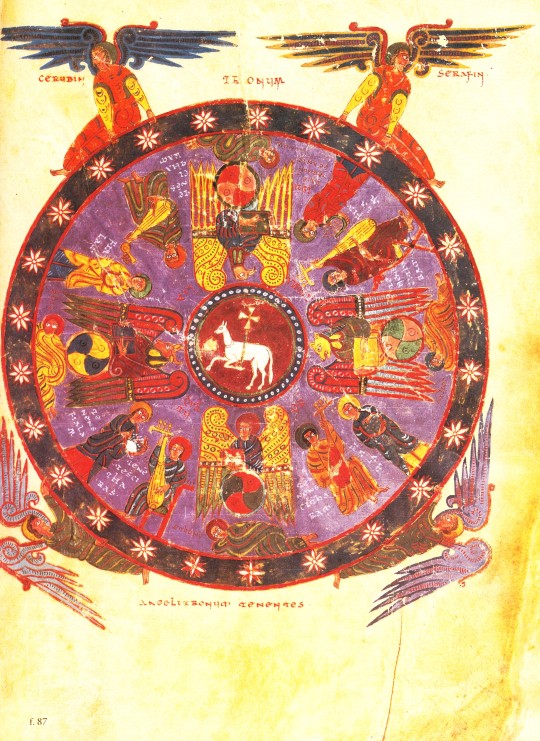

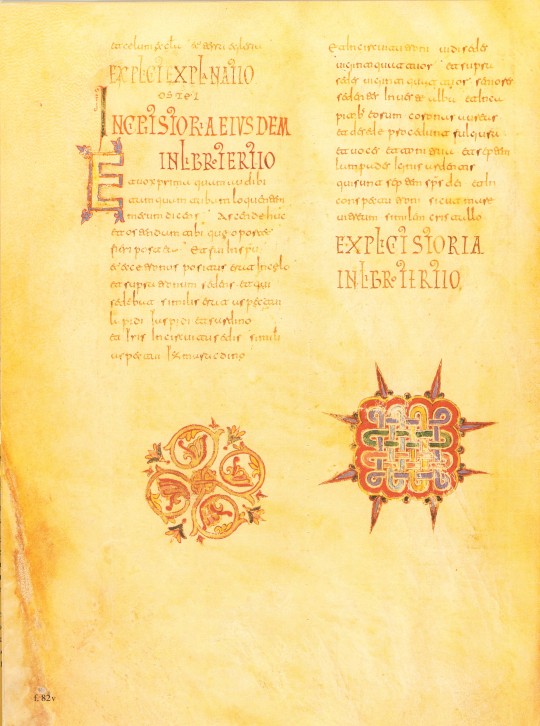
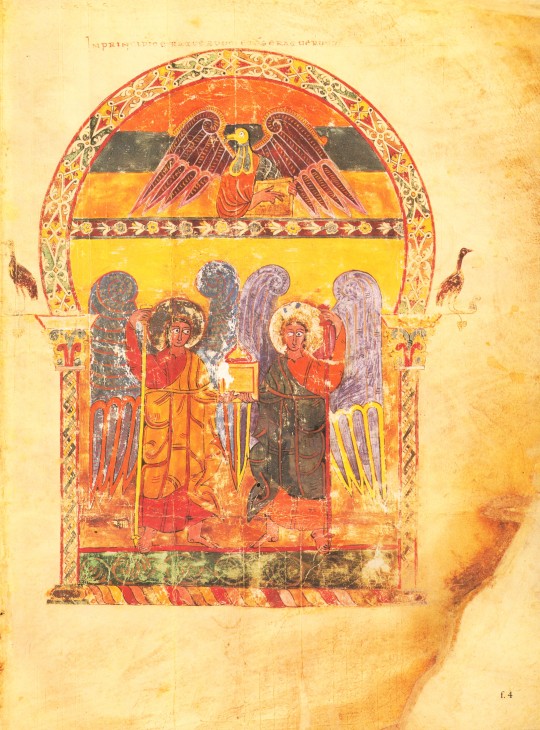

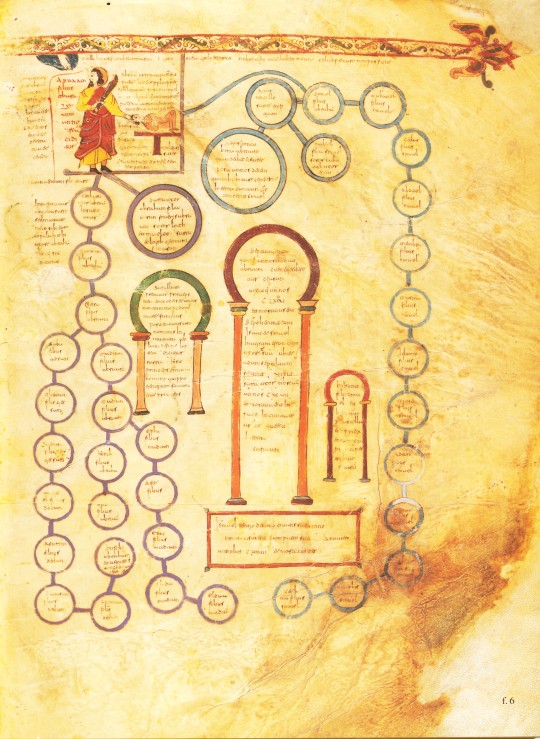


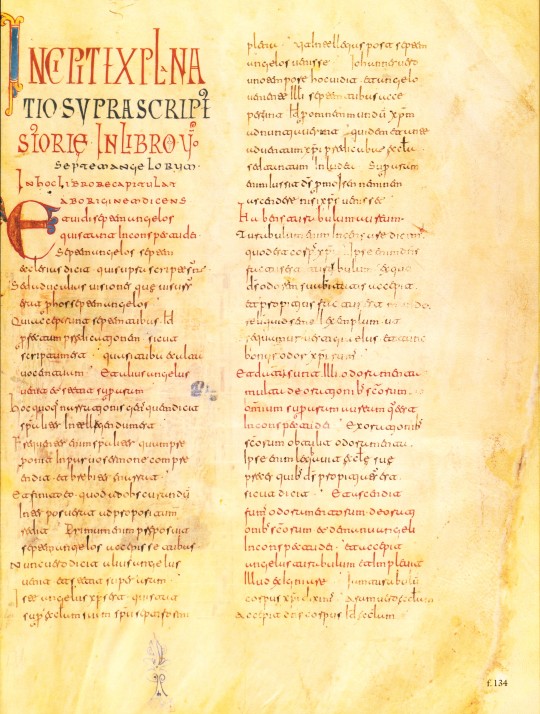
Welcome to Manuscript Monday!
In this series we will periodically focus on selections from our manuscript facsimile collection. Today we present selections from the Morgan Beatus Manuscript, reproduced as A Spanish Apocalypse, The Morgan Beatus Manuscript in New York by George Braziller, Inc. in association with the Pierpont Morgan Library in 1991. The original manuscript, made around 10th century CE at the scriptorium of San Miguel de Escalada in Spain by a monk named Maius, is the earliest surviving illuminated version of the monk Beatus of Liébana's commentary on the biblical Book of Apocalypse (also known as the Book of Revelation). The text of the Book of Revelation makes up the first part of the manuscript, and Beatus’s commentary comprises the second part. The Book of Revelation tells of the end-times in Christianity, during the final judgement of humanity by God. The story within this Biblical book was also seen by those living during the Latin medieval era as representative of the beginning of something new: God’s celestial kingdom. Due to this view of the book, many artists incorporated imagery from this part of the Bible in their work.
Produced in Al-Andalus, or Muslim-ruled Spain, the artistic style of this work combines both Muslim and Christian visual traditions to create a beautifully illuminated manuscript that supplements the commentary by the monk. This artistic style is known as the Mozarabic, which comes from the Arabic mustaʿrib, meaning ‘Arabicized’. Interestingly, this style of art can only be seen in Christian religious art and architecture from Spain at the time, as non-religious artistic objects made by Christians look so similar to Islamic versions of the same works that they cannot be identified as intentionally Christian. Some key Islamic artistic elements within the manuscript include buildings with horseshoe arches, intricate geometric and vegetal patterns as borders for larger images, and the large, bulging eyes of the illustrated animals.
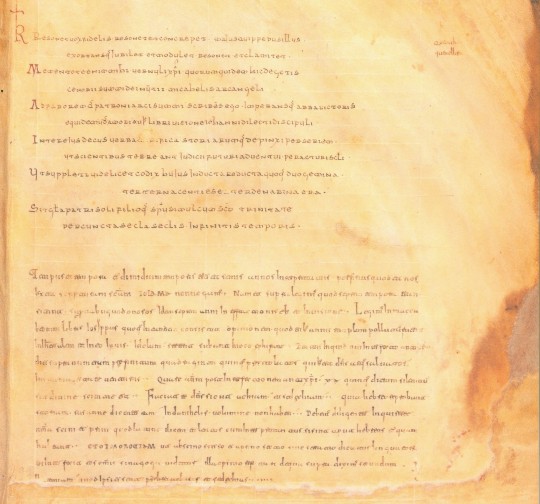
Another interesting aspect of this specific manuscript is the colophon at the end of the manuscript. It tells readers about the circumstances surrounding the creation of this book, including the maker, the patron, the year it was made, and an explanation about why Maius created the manuscript ("I write this . . . at the command of Abbot Victor, out of love for the book of the vision of John the beloved disciple. As part of its adornment I have painted a series of pictures . . . so that the wise may fear the coming of the future judgement of the world's end."). Colophons in medieval manuscripts are not usually as detailed, so the inclusion of all this information contributes greatly to the knowledge and history surrounding the Morgan Beatus Manuscript.
View more Manuscript Monday posts.
– Sarah S., Special Collections Graduate Intern
#manuscript monday#manuscripts#morgan library#morgan beatus manuscript#Beatus of Liébana#Spain#Christian art#Mozarabic#Islamic art style#facsimilies#Spanish art#Medieval art#Spanish medieval art#A Spanish Apocalypse#George Braziller#illuminated manuscripts#Sarah S.
139 notes
·
View notes
Text
image description by @swosheep

ID 1: all images are screenshots of an Instagram post by j3wess, and are on a light green background with an even lighter green grid pattern. The first image is a title written in dark green text. It reads: "Evangelicals are the primary supporters of Israel in the US, not Jews". There is two Stars of David beside the words 'not Jews'. A wavy green line underlines everything.
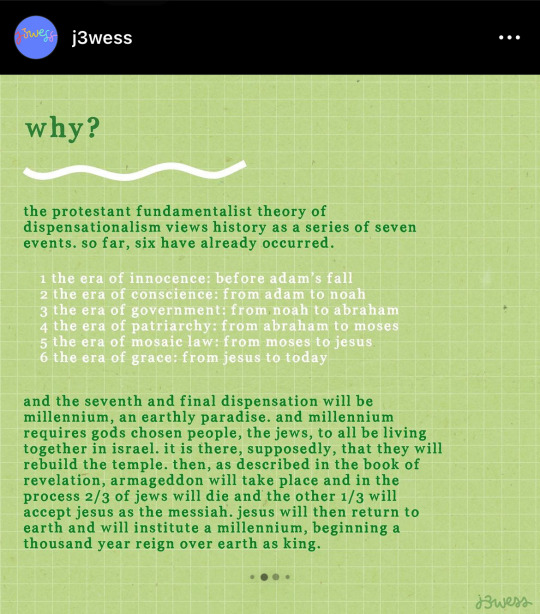
ID 2: the second image is titled "why?". The title is separated from the body by a wavy white line. The body text reads: "the protestant fundamentalist theory of dispensationalism views history as a series of seven events. so far, six have already occurred." An ordered list, in white text, reads: "1 the era of innocence: before adam's fall. 2 the era of conscience: from adam to noah. 3 the era of government: from noah to abraham. 4 the era of patriarchy: from abraham to moses. 5 the era of mosaic law: from moses to jesus. 6 the era of grace: from jesus to today." The green body text continues: "and the seventh and final dispensation will be millennium, an earthly paradise. and millennium requires gods chosen people, the jews, to all be living together in israel. it is there, supposedly, that they will rebuild the temple. then, as described in the book of revelation, armageddon will take place and in the process 2/3 of jews will die and the other 1/3 will accept jesus as the messiah. jesus will then return to earth and will institute a millennium, beginning a thousand year reign over earth as king."
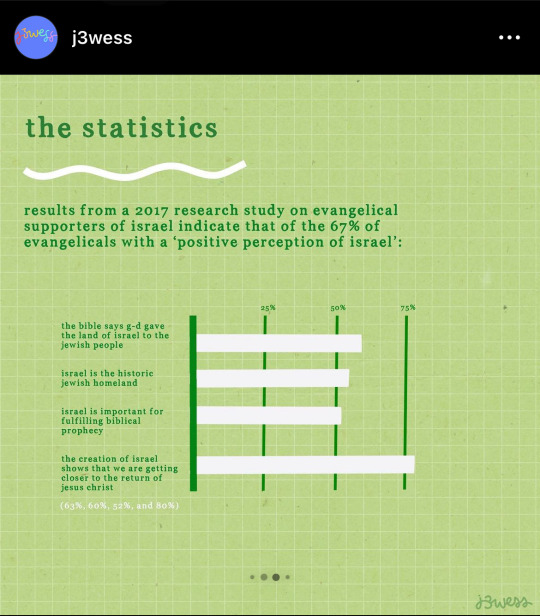
ID 3: the third image is titled "the statistics". a white wavy line separates the title from the body text. The body text reads: "results from a 2017 research study on evangelical supporters of israel indicate that of the 67% of evangelicals with a 'positive perception of israel':" Below, there is a bar graph. The first bar is captioned: "the bible says g-d gave the land of israel to the jewish people". The bar is at 63 percent. THe second bar is captioned: "israel is the historic jewish homeland". The bar is at 60 percent. The third bar is captioned: "israel is important for fulfilling biblical prophecy". The bar is at 52 percent. The fourth bar is captioned: "the creation of israel shows that we are getting closer to the return of jesus christ". The bar is at 80 percent.

ID 4: The fourth image is titled "what's scary about this?" A white wavy line separates the title from the body text. The body text reads: "a majority of christian support for zionism and israel is because it will supposedly trigger the return of christ. in order for this to happen requires for a) all diasporic jews to return to the land, therefore displacing palestinians and b) jews to be either proselytized and abandon their own religion for christ or die." Below this text, a second title reads: "what's even scarier?". Body text reads: "despite israel claiming to represent and protect all jews, it prioritizes the support of evangelicals."
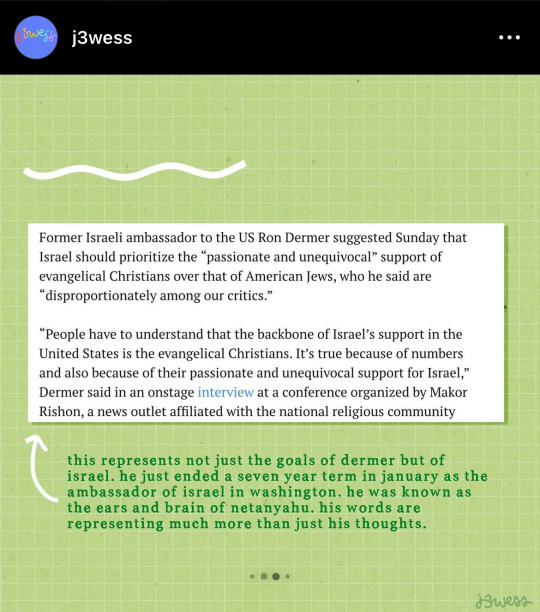
ID 5: the fifth image is untitled. It has a screenshot from an article which reads: "Former Israeli ambassador to the US Ron Dermer suggested Sunday that Israel should prioritize the 'passionate and unequivocal' support of evangelical Christians over that of American Jews, who he said are 'disproportionately among our critics.' 'People have to understand that the backbone of Israel's support in the United States is the evangelical Christians. It's true because of numbers and also because of their passionate and unequivocal support for Israel,' Dermer said in an onstage interview at a conference organized by Makor Rishon, a news outlet affiliated with the national religious community". Green text below it says: "this represents not just the goals of dermer but of israel. he just ended a seven year term in january as the ambassador of israel in washington. he was known as the ears and brain of netanyahu. his words are representing much more than just his thoughts." There is a white arrow pointing from the green text up to the article screenshot.
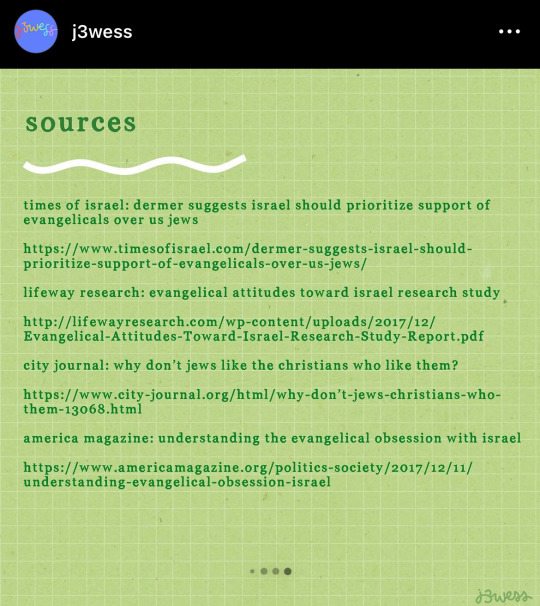
ID 6: the sixth image is titled "sources". There is a wavy white line separating the title from the body text. The body text consists of four sources, which are as follows: "times of israel: dermer suggests israel should prioritize support of evangelicals over us jews. lifeway research: evangelical attitudes toward israel research study. city journal: why don't jews like the christians who like them? america magazine: understanding the evangelical obsession with israel."
working links include:
#resources#palestine#jewish#israel#united states#evangelicals#instagram#reaux speaks#colonialism#genocide#occupation#religion#free palestine
107 notes
·
View notes
Text
by Elchanan Poupko
For centuries, rabbis around the world get up on Shabbat Zachor and speak about memory, never about violence. Not once in the past 2000 years of Jewish history – and that is a vast record to draw on – was the Biblical account of Amalek used to evoke revenge. It was always used to evoke memory. The imperative to remember the unprovoked atrocities committed against our own innocent communities.
The name of Amalek was invoked to remind us of the ubiquitous nature of antisemitism, the only hate in the world directed against people who are unknown to those seething with hate for us. People like the Houthis in Yemen who never saw a Jew in their life, yet are determined to destroy the Jewish state; Nazis in Germany who traveled hundreds of miles away from home to kill Jews in Belarus, Lithuania, Hungary, and Morocco even though they had never seen or known much about those Jews, that is the kind of evil we speak about when invoking the memory of Amalek.
In our generation, when speaking about that kind of senseless hate, we speak about the Hamas terrorists who woke up on the morning of October 7th and were willing to gable away their lives and futures to murder and burn alive people like Canadian peace activist Vivian Silver, someone who spent her life driving Palestinians from Gaza to medical appointments in Israel’s best hospitals. We invoke the memory of Amalek when we encounter something so evil it defies any logical explanation.
It is appalling to see how many people rushed to the Bible to judge Israel’s use of the memory of Amalek before looking at its use for the past 2000 years, most notably during the Holocaust.
While Germany starved to death and killed hundreds of thousands of Jews in the Warsaw Ghetto, Jews secretly published a newsletter called Kol Hamidbar in which the emaciated Jews wrote: “Many nations waged war against the Jews and did bad unto them, but Amalek, that is something absolutely different. Amalek put the destruction of Jews as a goal, a program, a method; premeditated, in cold blood, sadistically, according to a plan, organized, and with laws… Amalek and their grandson Haman are not satisfied with the killing of individual Jews…they would like to destroy the entire nation and eliminate Judaism.”
These words ring powerfully to any Jew who has seen what Hamas terrorists did on October 7th. The senseless hate that defies any logic or pattern of human conflict is simply unexplainable. The kidnapping of grandmothers from their homes and burning of babies and little girls alive with no reason whatsoever has no other language.
Jews invoke this language of Amalek when we encounter the world’s oldest hate, acted on with cruelty no human can explain. Jews have done so countless times while remembering the Holocaust and also did so while seeing the evils of Hamas on October 7th.
Like Jews after the Holocaust, the memory of Amalek’s unforgivable horrors reminds us of the need to take action. How does that action look? Years ago, speaking to congregants in synagogue, here is what I said as I spoke of the story of Amalek, and I was not the only one:
“The greatest heed to the call ‘Yidden, Nekama – Jews, Revenge’ inscribed in blood in Slabodka, Lithuania, is not going back to that town and place or to those perpetrators; it is that there are today thousands of students in Israel learning in Yeshivas named Slabodka. It is that we are undeterred in leading proud Jewish lives, laser-focused on the future while refusing to forget the past.”
Jewish revenge never looks like the acts of our enemies. We never follow in the inhumane footsteps of those who committed the unthinkable against us. This is true also concerning the horrors of October 7th.
57 notes
·
View notes
Text
channeled message: 12/15/24:
I have a message for you, I spoke briefly some time ago advising people of African American descent as well as other groups of people of color to turn back to their ancestral roots and spiritual practice and traditions through study and through searching for your lineage and where that takes you spiritually. Many people of color (I am speaking especially to black women those of which are African American or African) do not realize that their suffering in this world stems from the disconnection of their ancestral traditions and their spiritual duty and service. A time is upon us, the ending of a cycle or a great ending comes every 1,000 or in some cases every 6,000 years. Today we're sitting in the age of Aquarius which represents themes like innovation, technology, progress forward, humanitarianism, community, freedom and rebellion, and spiritual awakening and consciousness shifts.
Before I get any further into that, I want to speak briefly about something that has called upon my attention through my studies, the people of (Kemet) Egypt, Nubia, Lybia or Libya, Syria, Pelasheth (or actually Palestine), as well as African/African American People(s), are of direct lineage to the original first prophets, priestesses, and priests of the Oannes. I say this because we are witnessing a repetition of a historical tale our people(s) have seen before on various occasions, I said once or many times that the oppressor has a pattern of behavior that has worked for ages, and as of right now is being broadcasted across the world as we are in a time in which lies no longer spread faster than the truth. It's important to acknowledge that the Syrians, the Palestinians, the Egyptians, and people of the African Diaspora (both African American and African) continue to face issues created by the Western world due to resources. The Middle East and Africa is still quite prosperous hence why we see America and Israel over there now attempting to irradicate and exploit the people who live there and their land. If you know anything about the Bible or the Old Testament, you know already that the Philistines or the Palestinians clash with the Israelites over fertile lands and strategic trade routes.
Stay with me now, because this going to sound insane, but I believe that the Palestinians and the exploitation and horrific acts committed against them marks this moment in history where we become increasingly and undeniably aware of the the cruelty and intentions of the Western world, it's leaders, and it's politicians. I believe this because our God; The Divine Mother (whom due to spiritual ignorance we believe to be male), sent over the first prophetesses/priestesses on the Argos (Ark) after the Great Flood with "Noah". In the Chaldean/Babylonian account of the story our God is considered to be Goddess Aruru-Ishtar/Ishtar (who is often associated with the Goddess Inanna) Ishtar is angered at the rebellion and betrayal of her people (I know you've heard this story before) and so she floods "the world" or the world as her people know it. And on the seventh day she "sent forth a dove(s)" (which would depict the first prophetesses) to test for dry land and one of the doves was said to have returned carrying an olive branch for the Goddess Minerva (who is the patron of civilization) the olive branch/the olive tree, as we know, is a stable symbol for the Palestinians representing their resistance, the olive branch represents peace, reconciliation, and hope. And the Dove returning with the olive branch from my understanding represents the harmony of intellect and spiritual renewal after chaos.
I believe that we are entering a time, divinely orchestrated to restore us from spiritual poverty and set forth transformation as we move away from the 1000's of years now spent indoctrinated by ignorance and oppressed by the enemy. This story is as old as time, I believe that our time has come to return to tradition and further will ourselves forward in the direction of change. I once told my father before that the "god" of the elitist, the politicians and world leaders on this plane of existence and reality as we know it is not our God. Their "god" a figure not born out of faith, spirituality or a divine right to do right by the people is the deity of those whose intention was and IS still power, influence, colonization, the eradication of Gods real people, and exploitation that has aided in the indoctrination of many, spiritual ignorance, and horrific wars and violence. The ability and power to suppress people, conceal and get rid of Deities, prophecies, and people who have the divine power to not only expose the weakness and ultimate coming downfall of a Nation but destroy it entirely has always been the goal.
These are the same people who accused King Solomon the alleged King of Israel of marrying "many other women" outside of those he was encouraged and allowed to marry who came from the same polytheistic religions and cultures he came from (that we came from before the taking over of monotheism!!) due to the belief that "foreign" influences could lead the Israelites away from "Yahweh" and otherwise lead to the religious corruption and the fall of Israel. if that's not a enough to make you get the f*ck asap I don't know what will!!!!!
It also back up my claims that this message is a calling to people of color everywhere, in my studies and in my observation of other countries who do not believe in the western fallacy of "race", There was no such thing in our world long ago before the corruption of colonization. "Race" is a western-man-made idea in order to draw a distinction between white individuals and those of outside ethnic groups. In the concept of "race" white is the standard if you fall outside of that you are the minority. In our world before, it is important to recognize that members of a different origin, group, or complexion were designated as such to identify the path of deity they descend from.
if you need to hear anything else, let us look at the Pledge of Allegiance for America:
"I pledge allegiance to the flag of the United States of America, and to the republic for which it stands, one nation under God (singular), indivisible (which means "incapable of being divided or separated") (division is aiding in the fall of America), with liberty and justice for all."
The Declaration of Israel essentially has a similar theme, I believe that American politicians, who are predominantly right leaning believe in the mixing of "god" and state. Polytheism and the awakening of people of color and movement towards ancestral and cultural practices (even just on the surface of acknowledging that our God is not Male) will further aid in the division of the nation. As mentioned, people of color (in whatever ways we separate them) have historical and ethnic ties to cultures and spiritual practices they once drew great power and guidance from.
(In my, what appears to be delusion or spiritual psychosis) I believe that the message I am sharing with you all was given to me to share for a reason.
As a Erythraean prophetess once said in 2802 B.C. ; "They will say that the Sibyl is mad, and deceitful, but when all things shall come to pass, then ye will remember me; and no one will any longer say that I, the prophetess of the great Goddess am mad."
7 notes
·
View notes
Text
THIS DAY IN GAY HISTORY
based on: The White Crane Institute's 'Gay Wisdom', Gay Birthdays, Gay For Today, Famous GLBT, glbt-Gay Encylopedia, Today in Gay History, Wikipedia, and more … November 13


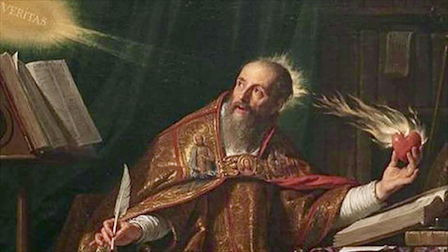
354 AD – Early Christian writer St. Augustine was born on this date (d.430) Following the example of St. Paul, Augustine set the standard for confessional literature that was to flourish in the centuries that followed. The pattern, of course, is a detailed listing of one's sins, followed by a narration of some event or events that made one long for salvation, and then an enunciation of the pains and joys of penance with the hope of future redemption.
Augustine confessed not only to having fathered a son, but to friendship that was classically homoerotic. When he was a young man, his closest friend died and Augustine contemplated joining him in death. "I felt that his soul and mine were `one soul in two bodies'; and therefore life was to me horrible because I hated to live as half of a life; and therefore perhaps I feared to die, lest he should wholly die whom I loved so greatly. My longing eyes sought him everywhere." Augustine, of course, cast off all sins of the flesh and becoming one of the great founders of Christian doctrine, admonished us all to do the same.


1759 – In the Netherlands, minister Andreas Klink is banished for life for having committed sodomy. He defends his attractions as natural.


1879 – Marcus Behmer (d.1958) was a German writer and book illustrator, graphic designer and painter.
Marcus Behmer was a son of the painter Hermann Behmer. His uncle Rudolf Behmer, known as a breeder of Merino sheep - was the twin brother of his father. His brother Joachim Behmer was also active as an artist.
His artistic beginnings came with his first major success with the illustrations for Wilde's Salome in 1903. The early works show the influence of the illustrations of Aubrey Beardsley.
On 1 October 1903 Behmer entered military service, was appointed a corporal in 1904 and promoted in 1907 to sergeant. From 1914 he participated in the First World War (in Flanders and in Poland). In the summer of 1917 he fell ill "after an operation in the field" and was six weeks in the military hospital of Jarny . During his time in the army, many so-called "comrades' portraits" emerged, usually reduced, although finely crafted profile views of young soldiers
From 1902 Behmer produced illustrations for books, designed initials and writings, and was responsible for carefully planned publishing facilities. He worked for the Cranach Press of Count Harry Kessler and illustrated numerous articles for the monthly magazine "The Island."
Behmer had been since 1903 a member of the first homosexual organization in the world in Berlin. Because of his homosexuality, Behmer was sentenced in April 1937 by a court in Konstanz to imprisonment of two years. At times he was given the opportunity to work as an artist in prison. The works produced in this period are mostly calligraphic tablets with Greek text (prayers and Bible quotes), and drawings full of bitterness and irony.


1950 – Charles Kaiser is an American author, journalist and academic administrator. In 2018 he was named Acting Director of the LGBTQ Public Policy Center at Hunter College. He is also a nonfiction book critic for The Guardian (US).
His book about one family in the French Resistance, The Cost of Courage (2015) received enthusiastic reviews from The Washington Post, The Wall Street Journal, and The Christian Science Monitor, among many other publications. It also won the grand prize at the Paris Book Festival (2015). In 2016 it was published in France by Seuil as Le Prix du Courage.
His blog about the media, Full Court Press, originated on the website of Radar Magazine in the fall of 2007. He continued it at the Columbia Journalism Review and the Sidney Hillman Foundation until the spring of 2011.
The son of a diplomat, Philip Mayer Kaiser, he grew up in Washington, D.C., Albany, New York, Dakar, Senegal, London, England and Windsor, Connecticut. He has lived on the Upper West Side of Manhattan for many years.
He is the author of The Cost of Courage, 1968 In America, and The Gay Metropolis. The Gay Metropolis was a Lambda Literary Award winner, as well as a New York Times Notable Book of the Year. He was a guest on the Colbert Report, where he discussed a new edition of The Gay Metropolis. He wrote the afterword for a 2012 edition of Merle Miller's landmark work, On Being Different: What it Means to Be a Homosexual. That afterword was excerpted on the website of the New York Review of Books. In 2015 he was inducted into the LGBT Journalists Hall of Fame.

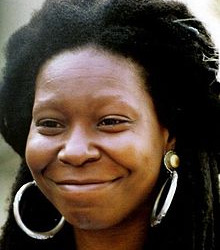
1955 – Caryn Elaine Johnson, best known as Whoopi Goldberg is an American comedian, actress, singer-songwriter, political activist, author and talk show host. She is a strong supporter of the LGBT community.
On April 1, 2010, Goldberg joined Cyndi Lauper in the launch of her Give a Damn campaign to bring a wider awareness of discrimination of the LGBT community. The campaign is to bring straight people to ally with the gay, lesbian, bisexual, transgender community. Other names included in the campaign include Jason Mraz, Elton John, Judith Light, Cynthia Nixon, Kim Kardashian, Clay Aiken, Sharon Osbourne and Kelly Osbourne.
Goldberg's high-profile support for LGBT rights and AIDS activism dates back to the 1987 March on Washington, where she was one of few celebrities participating.


1969 – Today is the birthday of bi-sexual Scottish actor Gerard Butler. He is best known for his portrayal of King Leonidas in the intensely homoerotic film about the Spartans, 300. He also portrayed the Phantom in the 2004 film version of The Phantom of the Opera. He is slated to portray the iconic Scottish poet Robert Burns in an upcoming biopic.
In the gossip mags, there have been numerous stories of his romantic involvements - including several of romantic and/or sexual involvements with other male stars.
In a 2004 Movieline interview he said:
"I talk about my sexuality, but it's always glossed over. People seem to shy away from the issue. Whenever it is discussed, it's distended and exaggerated. Gerard Butler is Gay. No I'm not. I don't know myself what I am so it can be bewildering to see that being plugged. I have been in relationships with women. And men. That doesn't make me Gay. That doesn't make me straight. It's hard enough to go through these things in my mind without being scrutinised about it so there are times when you want to close the door and say my sexuality is my own personal business."


1999 – Josh Cavallo is an Australian professional association footballer who plays as a left back and central midfielder for Adelaide United. Cavallo has represented the Australian under-20 national team.
Cavallo was born in Bentleigh East, Victoria.
Cavallo represented both Melbourne Victory FC Youth and Melbourne City FC Youth. Western United. On 15 April 2019, Melbourne City announced that Cavallo would leave the club at the expiration of his contract at the end of the 2018–19 season.
On 24 June 2019, new A-League side Western United announced that Cavallo would join the club ahead of its inaugural season. He made his debut on 3 January 2020 in a 3–2 loss at his previous club. On as a 71st-minute substitute for Apostolos Stamatelopoulos, he earned a penalty when fouled by goalkeeper Dean Bouzanis, which was converted by Besart Berisha. Western United announced that Cavallo was leaving the club on 10 February 2021.
On 18 February 2021, Cavallo signed a short-term contract to play for Adelaide United. After a successful stint in the 2020–21 A-League, he signed a two-year contract extension on 11 May. He was rewarded with Adelaide United's A-League Rising Star award after a successful 2020–21 campaign, in which he started 15 games and made 18 appearances.
Cavallo came out as gay in October 2021. At the time, there were no other openly-gay male footballers playing professional top-flight football, in the world. In becoming the first to do so, he said in a statement, "I hope that in sharing who I am, I can show others who identify as LGBTQ+ that they are welcome in the football community."


8 notes
·
View notes
Text
#Lu rambles#polls#the shampoo bar was specifically bc I asked the lady if she had any stuff good for dyed hair and she said#that she has a hairstylist friend who uses her stuff even on vivids bc it's really color safe!!#I'm already seeing a LOT of fade after 3 washes of this dye so hopefully this will work better#whenever I refresh the black color :)#the woodburning was literally like 20 bucks I was like that is SUCH a good price and I love it
16 notes
·
View notes